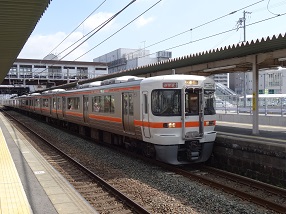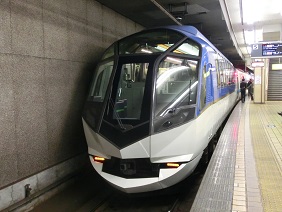This page invites you to ride trains in Japan for your own private travel!
- Contents -| Updated: Sep. 18, '16 | ||
|
Detail Information of Railway in Japan |
||
| * Japan Railways Lines | Updated: Sep. 25, '16 | |
| * "Shinkansen", Bullet Trains | NEW ! May 17, '20 | |
| * Other Private Railways | (Under Construction) | |
| * Street Cars | (Under Construction) | |
| * Cable Cars | (Under Construction) | |
|
Welcome on Board! |
||
| * Scenic Train Lines | (Under Construction) | |
| Manners in Trains | (Under Construction) | |
|
- General Information -
Japan has well developed train systems, especially in urban areas.
System length is approximately 27,800km, nationwide.
Twenty-thousand km. are Japan Railways (JR) lines and the rest of the 7,800km. are other privately owned railroads companies. For the detail explanation of JR lines, please visit the page of Japan Railways: http://cf916626.cloudfree.jp/HandE_Japan/RidingTrains/JRlines.html In Tokyo and Osaka areas, trains are the main means of transportation, rather than by driving cars. Train frequencies are very high in these areas. In the Osaka and Nagoya areas, rapid train services provide very fast means of transportation from the downtown of core cities to the suburbs.
Shinkansen known as "Bullet Train" runs more than 260 km/hr. (163 MPH) or faster.
The maximum speed of Shinkansen is 320km/hr. (200MPH). For the detail explanation of "Shinkansen", please visit the page of Shinkansen: http://cf916626.cloudfree.jp/HandE_Japan/RidingTrains/Shinkansen.html Shinkansen runs from Hakodate in Hokkaido to Tokyo and from Tokyo to Kagoshima in Kyushu, by connecting Sendai, Saitama (Omiya), Tokyo, Yokohama, Nagoya, Kyoto, Osaka, Kobe, Okayama, Hiroshima, Kita Kyushu and Fukuoka (Hakata). These cities have approximate populations of one million or more. Shinkansen also runs from Tokyo to Kanazawa through Nagano, and also to Niigata. 
Yamagata Shinkansen and Akita Shinkansen are branch lines of Tohoku Shinkansen. Trains are useful, convenient and reliable means of transportation in Japan, especially within urban areas and by Shinkansen.
JR lines were formerly Japan National Railways, owned by the government.
Some third-sector railway companies were also Japan National Railways.
JR Train System Map: http://www.jrpass.com/map
In urban areas, which consist of Tokyo, Nagoya, Osaka, Hiroshima and Fukuoka, private railway companies have their own railway network, in addition to JR railway network. Their services are often better than JR lines in terms of train frequency and fares. Many cities in Japan discontinued street car service in the 1960s. Currently, only 16 cities have street car service. They are very convenient transportation inside cities. 16 cities are Sapporo, Hakodate, Tokyo, Takaoka, Toyama, Fukui, Toyohashi, Osaka, Sakai, Okayama, Hiroshima, Matsuyama, Kochi, Kumamoto, Nagasaki and Kagoshima. |
|
In rural areas, the main train system is JR. Unfortunately, train frequency is not often. Sometimes, trains run only once every 2 or 3 hours. There are also third-sector railway lines in rural areas. Their train frequency is much better. In many cases, such third-sector companies run trains at least once every one hour. Actually, deep planning is required to run trains in rural areas, but the scenery from trains is really beautiful. You will see real and true Japan; mountains, rice and vegetable fields, old houses,,,etc.
Go to the top page of "Historical and Exotic Japan":
http://cf916626.cloudfree.jp/HandE_Japan/HandE_Japan.html  Home Page in Japanese: "Shane's HomePage"
Home Page in Japanese: "Shane's HomePage"http://cf916626.cloudfree.jp/index.html 
|



